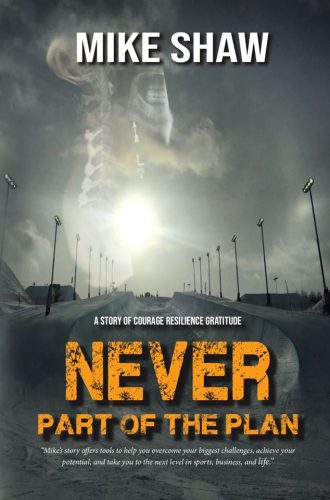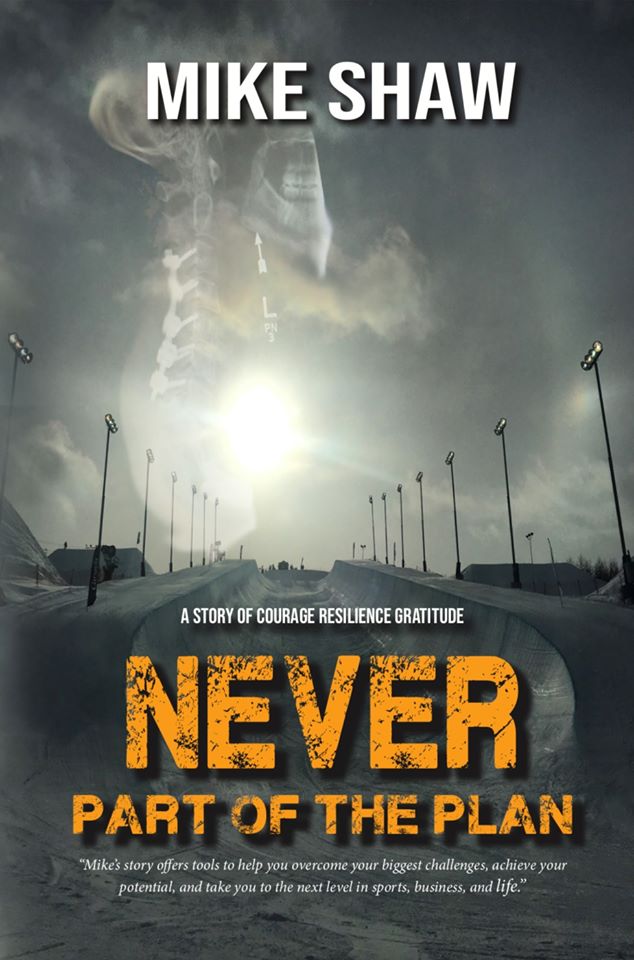Four questions with Mike Shaw
 By Will Johnson
By Will Johnson
Mike Shaw was coaching freestyle skiing all over the world, the culmination of a lifelong love affair with the sport, when an unexpected injury nearly left him quadriplegic in 2013. As he began to heal, overcoming mental health hurdles and committing to being grateful every day, he found himself on a new track as an inspirational speaker and author. Sport for Life sat down with him to hear about the lessons he’s learned during his journey.
#1. Your upcoming memoir Never Part of the Plan gives readers a firsthand glimpse into your headspace before, during and after a devastating accident that nearly left you paralyzed from the neck down. It was the sort of experience you never could have planned for, but simply had to survive. How did you find the mental fortitude to make it through that experience, and what have you carried forward into the rest of your life now that you’re fully mobile again?
Never Part of the Plan is about overcoming the biggest challenge I’ve ever faced.
After my accident and spinal cord injury, I had to develop a level of mental fortitude that came directly from my experiences with freestyle skiing. You cannot progress in sport without pushing to the point of failure, getting knocked down, and picking yourself back up to try again. Freestyle skiing is perhaps one of the best sports when it comes to developing resilience. I think skateboarders might have skiers beat, but either way, you can’t get better without mental toughness and the ability to pick yourself up after a big fall.
Gratitude played a significant role in helping me frame setbacks in the grand scheme. I was in rough shape, but I was thankful that anything—and I mean anything—in my body was coming back. When I had enough arm strength to brush my teeth for the first time I was so happy I cried. When I started transferring from my wheelchair to my bed on my own and when I started standing, gratitude was fuel for healing. I found strength and a perspective shift that kept me moving—all from feeling thankful.
Eventually I became hungry to get back on skis. I kept that goal in mind, absolutely, but I also saw plenty of people in the hospital that would have killed for the opportunity to walk again—like me. So I had to work hard. If not for me, for all the people with spinal cord injuries who would do anything to regain the use of their bodies. I activated gratitude, learned to fail forward, employed a growth mindset, and like all athletes, I relied on my team and my community to get me to the next level.
While I’m definitely not 100% healed—I still can’t feel the skin on my legs and there are plenty of other symptoms accompanying my injury that I struggle with—I am grateful every day for my second chance.
#2. At the 2020 Sport for Life Canadian Summit, you presented to delegates on Performance Driven Injury Prevention. Obviously we can’t prevent every injury, but we can work towards a sport culture that is as safety-conscious as possible. What were some of the primary takeaways you were trying to give attendees during your talk?
Nobody likes safety—yes, even coaches don’t like safety.
If you’re a coach who’s ever put an athlete on the court, field, ice or mountain with a taped ankle, wrist, or knee, what’s more important: performance or safety? Most will say safety, but our actions—like playing athletes when they’re not 100% healthy—speak louder than words. I’m not saying no one likes safety at all, it’s just not sexy.
Safety and injury prevention should always be a top priority, but instead of trying to force a behavioural change by pushing safety on coaches, players, and teams, we can focus on what everyone wants: better performances. If we address four vital states: rushing, frustration, fatigue and complacency—which cause 95% of acute injuries—we can prevent the critical errors that cause performance problems and injuries. It kills two birds at once.
If athletes learn to cope when they’re in those states, they’re less likely to screw up, and if you make fewer mistakes then you’ll be better at whatever you do. Most times, performance errors aren’t a matter of skill, it’s about whether or not you had your eyes and mind on task in that moment. If you get better with having your eyes and mind on task, performance improves. We’re talking about focus and concentration. It’s straightforward but deserves reinforcing with simple language.
Coaches and athletes get excited about achieving their potential. We can use that enthusiasm to prevent injuries.
#3. I’ve witnessed firsthand how you haven’t allowed your injury to prevent you from participating fully in day-to-day life. We first met on the Adams River, where you were going whitewater rafting and cliff jumping with Paralympian Josh Dueck. What do you find is the best way to approach fear management after going through a devastating injury like you did?
Fear is tricky. It’s usually accompanied by some level of anxiety. Together they can diminish progress.
Knowing your limit is important. If you don’t feel comfortable and you’re feeling the nerves before a game of competition or performing a new skill, taking a risk, etc., that’s a good thing. It means you are pushing your limits. However, if you push too far, and the risk is too great, and there’s legitimate fear, maybe you need to dial things back. Fear is a survival mechanism and something we shouldn’t ignore.
There’s a challenge threshold that all coaches need to know about. We need to challenge athletes enough that they feel the nerves and butterflies, but not fear. If there’s genuine fear, it means there is usually a skill gap to address before taking the next step. On the flip side, if nervous energy is not present and the athlete feels too comfortable, it probably means they are susceptible to complacency.
Complacency is the silent killer for athletes’ dreams. It causes injuries, true, but if an athlete isn’t feeling challenged and doesn’t feel the butterflies once in a while, they’re not trying hard enough. They won’t progress. It takes the fun out of it. Performance suffers. Sport needs to be fun. Athletes need to feel like they are progressing. The challenge is hyper important. Challenges should just slightly exceed skill level.
Fear isn’t fun, but pushing the needle, and pushing through “the butterflies” is fun. In the words of a skiing icon, Tanner Hall, “when you are having fun that’s when the medals come.”
#4. You are the co-founder of HeadStartPro, a series of videos intended to reach everyone from athletes to returning veterans. How did you originally conceive of this idea, and how was the project evolved since being introduced?
HeadStartPro originates from the mega successful safety training program called SafeStart. SafeStart addresses the human factors of safety to prevent injuries in the workplace. When I first learned about the concepts after getting hurt, I knew I had to do something with the technology in sports.
We started out helping teams to improve their safety. Our goal was and always has been to keep athletes healthy and active for life. An injury is the biggest problem an athlete can have. If you can’t play, you can’t perform. Like I said earlier, no one likes safety. It’s not something that makes you jump out of bed in the morning with exuberant enthusiasm, but being better than you were yesterday, that’s more than enough reason to put in some effort. So, performance drives safer behaviour. We figured it out.
We made the shift to performance and injury-prevention training with HeadStartPro a couple of years ago. We get a mix of teams that say they use it 100% for a mental training process to perform at a higher level and others that say it’s keeping them healthy.
Either way, it’s win win.
To check out Mike Shaw’s HeadStartPro eLearning at the Sport for Life Campus, click here.

